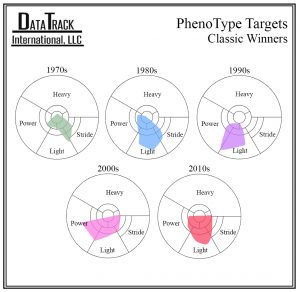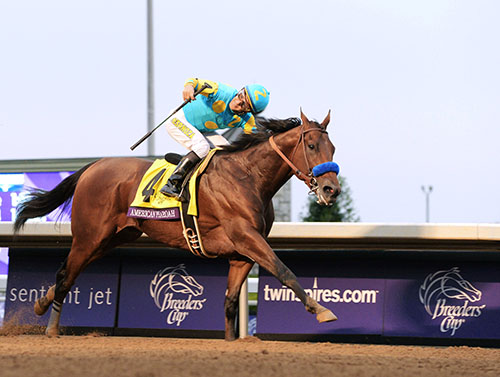By Robert D. Fierro
It appears that North American Classic winners are moving back toward the center of the breed, both phenotypically and–if it were still being updated–by Dosage Index.
Say what?
If one can wrap one's head around that hypothesis stated in the opening paragraph, this could be very interesting news for those who have worried for about a quarter of a century that the breed was “shortening up”–in effect, no longer producing the types of Classic horses which breeders produced since the importation of *Nasrullah, *Princequillo and *Royal Charger.
Let's start at the beginning. It is generally accepted that the most influential tool developed for assessing pedigree balance in the past half-century is the Dosage Profile developed by Dr. Franco Varola. This profile was defined by Varola as a typology which separated chefs-de-race (the most influential stallions) into “classifications” based on the aptitudes they passed onto their offspring. That's why his two books on the subject were titled The Typology of the Racehorse and The Functional Development of the Thoroughbred. (Remember those titles as we proceed.)
Those classifications are laid out on a page from left to right thusly: Brilliant – Intermediate – Classic – Solid – Professional.
Here are obvious examples of each classification listed left-to-right (Brilliant-to-Professional): Raise a Native – Dr. Fager – Northern Dancer – Secretariat – Stage Door Johnny.
Varola's work led to the wildly popular Dosage Index-initially promoted by Leon Rasmussen of Daily Racing Form, and subsequently refined by Jack Werk and Steve Roman independent of each other. Somewhere along the way the balance of classifications got out of whack because the stallions upon which the Index was based manifested themselves, as racehorses and progenitors, increasingly toward the left of the profile. As a result, some observers feel that this system is becoming obsolete.
We beg to differ.
Let's go back to the words typology and functional. Typology means “defining a type,” and in this case Varola was probably using that word as a substitution for genotype, or “the genetic constitution of an individual organism.” When you place that genotype into a specific environment–e.g., horse racing-you get a functional expression, which is also known as a phenotype. Thoroughbred biomechanics begins with determining a horse's phenotype and then, based on mechanical calculations, projecting how it should function in a racing environment.
What is interesting is Varola was mixing pedigree and mechanics. Though he didn't use the word “mechanics,” he described the horses he studied that way (read the books). If one extrapolates what he wrote in the 1970s, when the books were published, and followed the pile-up of chefs-de-race toward the left of the Dosage Profile, one could see that the balance of aptitudes has gone astray.
Therefore, it came as no surprise that the results of a study begun a decade ago found a correlation between Varola's typology based on pedigree and phenotype based on biomechanics. Not only was the Thoroughbred behaving functionally toward a type, but it could be clearly expressed by phenotype.
Accompanying this article is a graphic with five “phenotype targets” showing shaded areas that represent the distribution of American Classic winners in each of the past five decades. The targets are divided into sections which remarkably parallel the five Varola classifications. (It must be emphatically stated that the concept of the target was developed completely independent of Varola's findings). The similarity was discovered about a decade ago quite serendipitously. The targets show that phenotypes, like the Dosage Index, have changed since the 1970s, when both systems were in their infancy.
infancy.
A phenotype is determined by the algorithmic calculation of the balance of power, stride and weight that a horse possesses. Simply said, the closer a horse is to the center of the target, the more balanced it is in those respects-and prior to the 1980s, the winners of American Classics and Leading Sires tended to be close to the center of the Target, which could correspond to the Classic in Varola's terms.
The more power a horse has, the further left its position on the target (Brilliant); further to the right it has more stride elements (Solid and further out, Professional). Those close to the center but with a little more of Power or Stride are generally the blenders, or the Intermediates in Dosage terms. The Classics are right in the center of the Target or on the cusp.
As the shaded areas show, if one traces a line around the Phenotypes of the Classic winners through the last five decades, one can see in the 1990s a sudden shift to the left (Brilliance), typified best by Tabasco Cat, Thunder Gulch and Strike the Gold, and ending in the 2000s with Afleet Alex and Birdstone. There was also a mix of large and lightly made horses who were phenotypical outliers (Intermediates in some respects), such as Silver Charm, Colonial Affair. Then came a slow, but steady, repositioning in the 2010s toward the balanced center of the Target (Classic) such as American Pharoah and California Chrome, to Stride (Solid and Professional) such as Tonalist.
Does this mean the breed is changing? Perhaps a better description would be “evolving back.” It could be that everything old is getting to be new again.
(Bob Fierro is a partner with Jay Kilgore and Frank Mitchell in DataTrack International, biomechanical consultants and developers of BreezeFigs. He can be reached at bbfq@earthlink.net).
Not a subscriber? Click here to sign up for the daily PDF or alerts.






